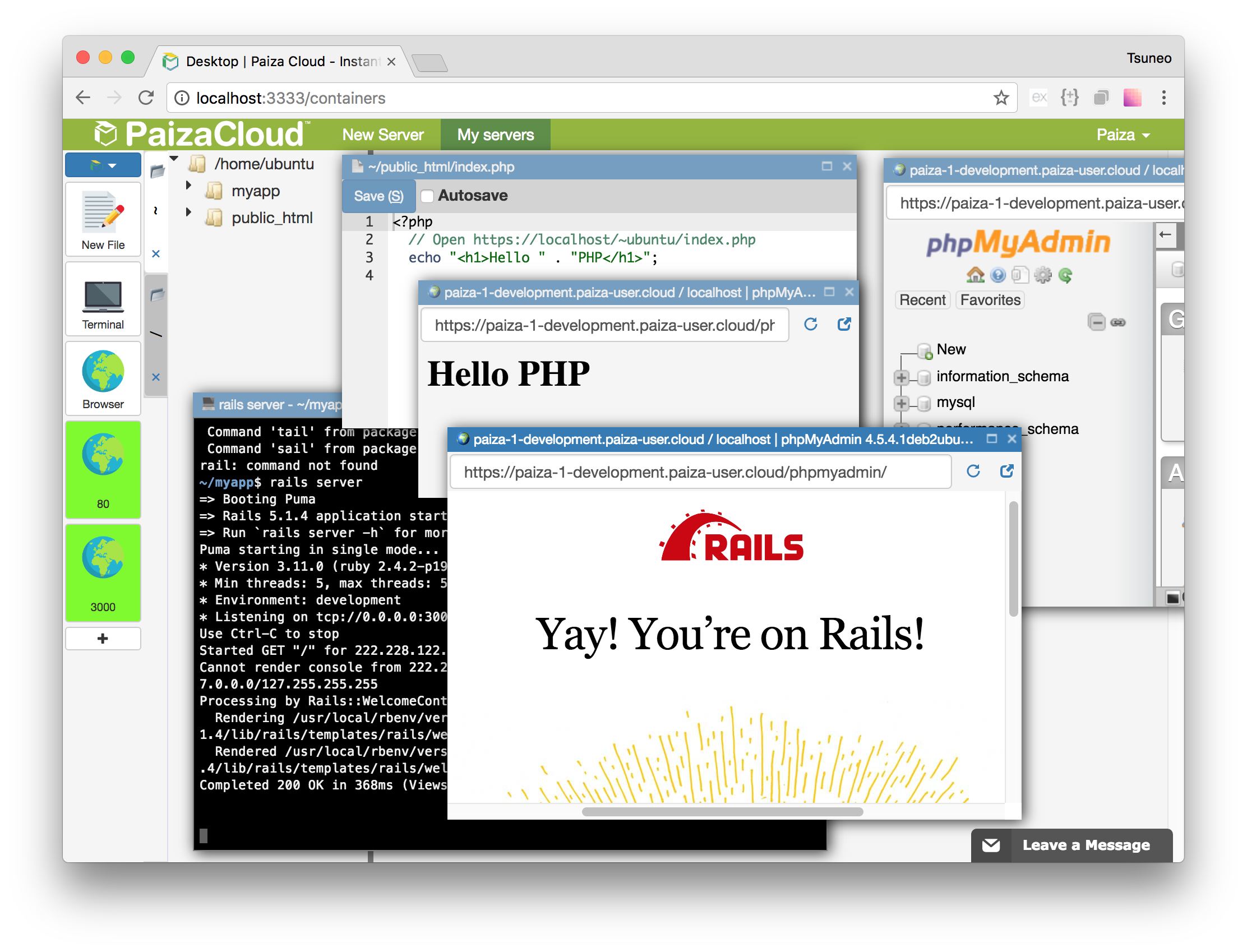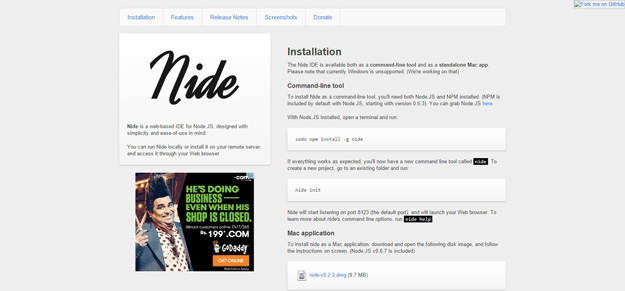- Node.js® is a JavaScript runtime built on Chrome's V8 JavaScript engine. Latest LTS Version: 12.19.0 (includes npm 6.14.8) Download the Node.js source code or a pre-built installer for your platform, and start developing today.
- Visual Studio Code. Visual Studio Code is possibly the best JavaScript ide for Windows, Mac,.
If you want a real IDE that works well on Mac OS X I would recommend IntelliJ IDEA. It has a JavaScript debugger and Node.js plugin. If you are looking for something more lightweight than a full-blown IDE, take a look at Sublime Text 2. Visual Studio Code, WebStorm, and Vim are probably your best bets out of the 19 options considered. 'Integrated debugging' is the primary reason people pick Visual Studio Code over the competition. This page is powered by a knowledgeable community that helps you make an informed decision.
Teletype for Atom
Great things happen when developers work together—from teaching and sharing knowledge to building better software. Teletype for Atom makes collaborating on code just as easy as it is to code alone, right from your editor.
Share your workspace and edit code together in real time. To start collaborating, open Teletype in Atom and install the package.
GitHub for Atom
A text editor is at the core of a developer’s toolbox, but it doesn't usually work alone. Work with Git and GitHub directly from Atom with the GitHub package.
Create new branches, stage and commit, push and pull, resolve merge conflicts, view pull requests and more—all from within your editor. The GitHub package is already bundled with Atom, so you're ready to go!
Everything you would expect
Cross-platform editing
Atom works across operating systems. Use it on OS X, Windows, or Linux.
Built-in package manager
Search for and install new packages or create your own right from Atom.
Smart autocompletion
Atom helps you write code faster with a smart and flexible autocomplete.
File system browser
Easily browse and open a single file, a whole project, or multiple projects in one window.
Multiple panes
Split your Atom interface into multiple panes to compare and edit code across files.
Find and replace
Find, preview, and replace text as you type in a file or across all your projects.
Make it your editor
Packages
Choose from thousands of open source packages that add new features and functionality to Atom, or build a package from scratch and publish it for everyone else to use.
Themes
Atom comes pre-installed with four UI and eight syntax themes in both dark and light colors. Can't find what you're looking for? Install themes created by the Atom community or create your own.
Customization
It's easy to customize and style Atom. Tweak the look and feel of your UI with CSS/Less, and add major features with HTML and JavaScript.
See how to set up Atom
Under the hood
Atom is a desktop application built with HTML, JavaScript, CSS, and Node.js integration. It runs on Electron, a framework for building cross platform apps using web technologies.
Open source
Atom is open source. Be part of the Atom community or help improve your favorite text editor.
Keep in touch
| GitHub | github.com/atom |
| @AtomEditor | |
| Chat | Slack |
| Forum | Discuss |
| Stuff | Atom Gear |
| RSS Feed | Packages & Themes |
Here’s how I get productive for JavaScript/Node on Mac OS.
It includes iTerm2, zsh, Node, Visual Studio Code and some git commands.
Table of Contents
Setup iTerm2
- Install iTerm2
Change edit mode to natural text
- iTerm Preferences → Profiles → select your profile → Keys tab → Load Preset… → Natural Text Editing (See this StackOverflow answer)
New session should start where previous left off
- iTerm Preferences → Profiles → select your profile → General tab → Working Directory section → Reuse previous session’s directory option
Quit on tab close
- iTerm Preferences → General, “Closing” → “Quit when all windows are closed”
Increase font size
- iTerm Preferences → Profiles → select your profile → Text tab → Font section → Change font → Update font in the popup
- Fan of 16pt Monaco (12, 14 is just too small)
Enable infinite history
- iTerm Preferences → Profiles → select your profile → Terminal tab → Unlimited scrollback
Shell setup
zsh

With oh-my-zsh manager. Sets you up with auto-completion.
snazzy colour theme
Using iterm-snazzy, which is a case of downloading the .itermcolors file and choosing the theme from (iTerm Preferences → Profile > Colors > Color Presets…).
Pure prompt
It’s simple, clean but gives you enough information to be productive.
(see Setup and configuration for how to get Node/npm up and running)
- Install using npm:
npm install --global pure-prompt - Initialise by adding the following to your
.zshrc:
As a developer it’s always good to have a few browsers and tools handy:
- Google Chrome: still a goto due to its solid and extensive dev tools. Usually I install the React or Vue dev tools.
- Postman for Mac: to manually test APIs
- Firefox: number 2 browser
- Brave: auto-blocks ads and tracking, sort of the “play” browser, its dev tools are a buggier/less ergonomic version of Chrome dev tools (this is because Brave uses Chromium under the hood)
- Safari - installed by default on Mac OSX, it’s a buggy browser, good to test using it since it surfaces weird SVG and cookies security policy quirks. Since it’s the default it’s also widely used by non-technical people.
- Enable the dev tools: Safari → Preferences → Advanced → Show develop menu in menu bar.
I use Visual Studio Code, it strikes the right balance between usable out of the box and customisable. The way I see it editors like vim or Atom need a bit of config before being productive, and others like Sublime or IDEs (WebStorm) don’t have the same plugin ecosystem.
Install VSCode command line tools
Open the dialog using CMD + P.
Use: Shell Command: Install 'code' command in PATH
The VSCode command line tool usage examples:
code .: open.directory in VSCodecode -r .: replace directory opened in VSCode with the current directorycode -a .: add current directory to VSCode, ie. initialises a workspace
Must-have extensions
- Atom keymap: I’m not a fan of the default keybindings, this uses Atom-style ones, get it from the Visual Studio Marketplace or
ext install atom-keybindingsfromCMD + Pmenu - EditorConfig for VS Code: “EditorConfig helps developers define and maintain consistent coding styles between different editors and IDEs.” (see editorconfig.org), ie. helps you deal with tab size, trimming spaces etc. across code editors, get it here from the Visual Studio Marketplace or
ext install EditorConfigfromCMD + Pmenu
Nice to have extensions
- ESLint: “Integrates ESLint JavaScript into VS Code.”, get it from the Visual Studio Marketplace or
ext install vscode-eslintfromCMD + Pmenu - npm Intellisense: “autocomplete npm modules in import statements”, get it from the Visual Studio Marketplace or
ext install npm-intellisensefromCMD + Pmenu - Snazzy theme: same colour theme (snazzy) as I’ve got setup for the terminal for VSCode, get it from the Visual Studio Marketplace or
ext install snazzy theme - Import Cost: “Display import/require package size in the editor”, get it from the Visual Studio Marketplace, or
ext install import-cost
Not many productivity apps, just Alfred, which I use as a better Spotlight Search and Clipy which is a clipboard manager.
Maccy
A simple clipboard manager designed for OSX.
It works out of the box better than Clipy (see below).
Install it through Homebrew:
Update the preferred hotkey to CMD + shift + v:
Paste by default on selection of a clipboard item:
Superseded by Maccy Clipy
Bump up the number of “inline items” (Clipy → Preferences → Menu → Number of items place inline).
Set your screenshots to save to clipboard + enable the option to paste as plain text (Clipy → Preferences → Beta → Paste as PlainText + Save screenshots in history).
Update Xcode using xcode-select--``install.
Install Homebrew for package managements (think apt or pkg for Mac):
Install Node.js either from source, using the Mac installer or using Homebrew:
Install n – Interactively Manage Your Node.js Versions using npm (now that we have Node installed):npm install--``global n
Switch to latest Node version using n:sudo n latest
Install jq (format and deal with JSON nicely in the terminal) and watch (run a command repeatedly) using Homebrew
Add a few git extensions:
- git-open: “Type
git opento open the GitHub page or website for a repository in your browser.” usingnpm install --global git-open - git-standup: “Recall what you did on the last working day.” using
git standup, there are multiple install options (see git-standup#install), I usually go with:brew install git-standup - git-lg: simpler/prettier
git log:
Add the following minimal .vimrc, which enables syntax highlighting, has basic tab/tabsize configuration and enables line numbers display:
Set up SSH keys and add to VCS hosting, see this GitHub help article:
- Generate a new key:
ssh-keygen -t rsa -b 4096 -C '*[email protected]*' - Copy your public key to clipboard so you can paste it wherever your hosted Version Control system asks you to:
pbcopy < ~/.ssh/id_rsa.pub
Put percentage on power level, right-click the battery indicator and select “Show Percentage”.
❤️ Spotify
More at my /uses page.
(Optional) Docker, VirtualBox
Docker is a containerisation technology, think VMs but smaller. I recommend Docker for Mac.VirtualBox allows you to run Virtual Machines on Mac, install it at VirtualBox downloads.
Nodejs Ide
Get The Jest Handbook (100 pages)
Take your JavaScript testing to the next level by learning the ins and outs of Jest, the top JavaScript testing library.
orNode Js Install

Free Node Js Ide
Join 1000s of developers learning about Enterprise-grade Node.js & JavaScript